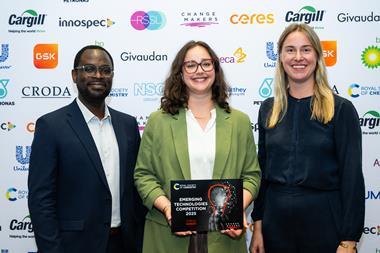Discovery could lead to novel photovoltaics made from just metals
Simply by shining light onto metallic nanoparticles, researchers in the US and the Netherlands have demonstrated an entirely new way to generate electrical energy. The finding could eventually lead to novel photovoltaic devices that do not rely on semiconductors or organic dyes, but are made from metals only.
The team, led by Harry Atwater of the California Institute of Technology, achieved this conversion of light into electricity by exploiting the behaviour of plasmons, oscillating clouds of electrons that are found on the surface of nanoparticles of certain metals. A nanoparticle of gold, for example, will have a plasmon oscillating at a certain resonant frequency. It is known that if electrons are introduced or removed from the plasmon, the resonant frequency will shift.

If the nanoparticle is sitting on a conductor, there will be random movement of electrons between the conductor and the plasmon. Atwater and his team reasoned that if light with a frequency that is very close to, but not exactly matching, that of the plasmon’s is shone onto the nanoparticle, the plasmon will ‘self-tune’ its resonance to that of the light. It does this by randomly shedding or acquiring electrons to or from the conduction surface. The reason it ‘wants’ to match the light’s frequency is because of a thermodynamic imperative: by absorbing the light it heats up, increasing entropy and reducing free energy.
So, depending on whether the plasmon is shifting its frequency towards that of blue or red light, the illuminated plasmon will hold on to or release the electrons that are moving randomly, thereby synchronising the plasmonic resonance with that of the light, and be held in this state for as long as the light is shining. This in turn results in a voltage difference between the nanoparticle and the surface.
The team tested the idea on two nanostructured systems, spherical gold nanoparticles 60nm in diameter, and a ‘plasmonic hole array’ consisting of holes of 100 nm diameter in a film of gold 20 nm thick.
‘Under steady state illumination we get a static potential,’ says Atwater. ‘The reason no-one has found it before is because no-body has looked for it. What we have demonstrated is one half of what you need for a power converting device. We now need to think about how we can convert that into a current.’
Other experts in plasmonics are impressed by the discovery. ‘They have invented through this ingenious and unobvious mechanism a wholly novel way for producing electricity from light,’ says Martin Moskovits of the University of California, Santa Barbara in the US. ‘Although the conversion efficiency is at present low, one can foresee significant future improvements.’
Nicholas Hylton of Imperial College London in the UK says: ‘What they have demonstrated is a new method of converting light into electrical energy. It has the potential to find a wide range of applications in a new class of opto-electronic devices, particularly if a technique can be developed to extract the energy as an electrical current.’












No comments yet